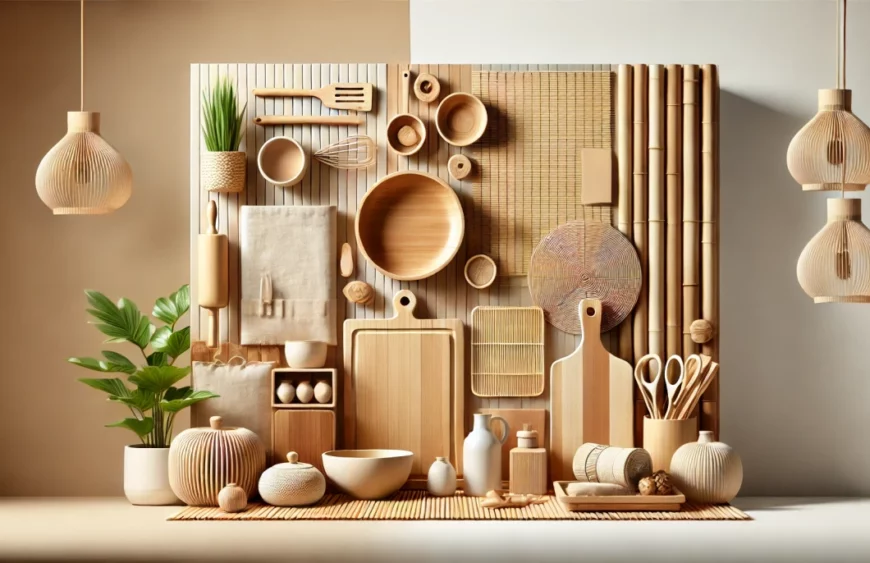竹製品の正しいお手入れ方法

竹製品は、持続可能で用途が広く、美観に優れた家庭用品として人気が高まっている。まな板や椅子からバンブーマットまで、これらの製品は今や日常生活の定番となっている。しかし、竹は柔軟で湿気に弱いという性質があるため、時間の経過とともにひび割れや虫食いなどの問題が生じることがあります。竹製品を長持ちさせるために、以下の実践的なお手入れ方法を参考にしてください。
一般的な竹製品のお手入れ
- 熱湯の使用を避ける
初めて竹製品を洗うときは、熱湯を直接かけるのは避けましょう。加熱ムラやひび割れの原因になります。竹の容器の中に長時間水を入れないでください。 - 優しいクリーニング
竹には "竹皮 "と呼ばれる保護層があります。強力な洗剤のような刺激の強い洗浄剤は避けてください。代わりに、マイルドな石鹸で洗い、十分にすすぎ、使用後は完全に乾かします。 - 新商品の塩水処理
初めて使用する前に、新品の竹製品をぬるま湯に溶かした塩水に約3時間浸し、その後30分間蒸すか煮沸する。こうすることで、カビやひび割れ、虫害を防ぐことができる。 - 適切な保管
竹製品をしばらく使わない場合は、十分に乾燥させ、防湿袋で密封し、余分な湿気を吸収する乾燥剤パックを入れる。 - 頻繁な使用とメンテナンス
定期的な使用と適切なクリーニングにより、竹製品は良い状態に保たれます。自然な輝きを保つために、表面を乾燥させ、汚れを落とします。 - 保護コーティング
クリアラッカーやタンオイルを塗ることで、虫害や湿気を効果的に防ぎ、竹製品の寿命を延ばすことができます。
特殊な保存技術
- 物理的方法
高温蒸し、浸漬、燻製、赤外線処理、マイクロ波乾燥などの技術により、有害な残留物を含まず、害虫が付かず、長持ちする竹製品を作ることができる。 - 化学的方法
竹は、浸漬、燻蒸、防腐剤の塗布などの方法で処理することもできる。効果的ではあるが、竹製品が食品と接触する場合は、これらの方法が食品に安全な化学薬品を使用していることを確認すること。
竹製品のお手入れ
竹フローリング
- 湿度コントロール
竹フローリングは湿度の変化によって収縮したり膨張したりします。乾燥した地域では加湿器を、雨季にはエアコンを使用し、バランスを保ちましょう。床を水にさらさないでください。 - 表面保護
出入り口にはマットを敷き、金属部分のある靴は避け、家具の脚には柔らかい素材のパッドを入れるなどして傷を防ぐ。
バンブーマットとクールマット
- クリーニングと保管
竹マットを水に浸したり、直射日光に当てたりしないでください。最初に使用する前に湿らせた布で拭き、定期的に柔らかく温かい布で拭いてください。汚れには中性洗剤をご使用ください。
保管する際は、マットが完全に乾いていることを確認してください。カンフルパウダーとタルカムパウダーを混ぜたものを表面に振りかけ、丸めて乾燥した場所に保管してください。 - タイプ別ストレージ
バンブーストリップマットとバンブーブロックマットでは、若干異なるケアが必要です:- バンブーストリップマット:石鹸水で洗い、すすいで乾かす。タルカムパウダーを塗布してから紙で巻く。涼しく乾燥した場所に保管する。あまりきつく巻かない。
- ブロックマット:繊維が切れないように慎重に巻く。
コレクターのためのヒント
コレクション性の高い竹製品は、温度(68~95°F)と湿度(35~40%)が安定している木製キャビネットに投資する。湿度の高い季節には、カビが生えていないか点検し、柔らかいブラシで掃除する。乾燥しすぎている場合は、キャビネットの中に水を入れた小さなコップや本などを入れてバランスをとる。
適切なお手入れをすれば、竹製品は自然の美しさと機能性を何年も保つことができます。日常生活で使うにせよ、コレクションとして大切にするにせよ、竹製品を最大限に活用するためのヒントをご覧ください。🌿

